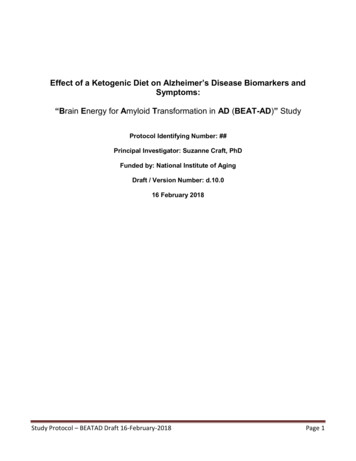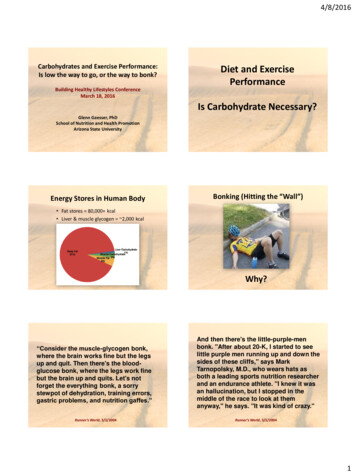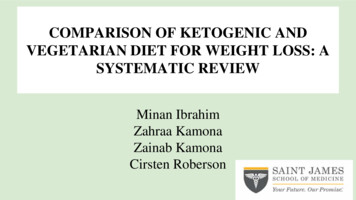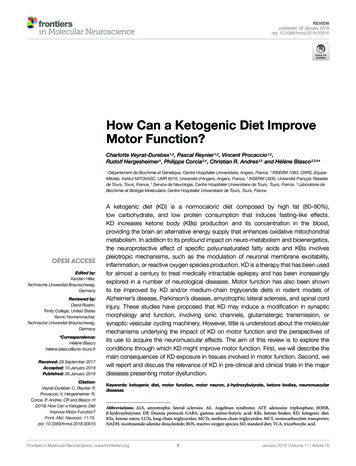
Transcription
Iacovides and Meiring Trials (2018) 19:62DOI 10.1186/s13063-018-2462-5STUDY PROTOCOLOpen AccessThe effect of a ketogenic diet versus ahigh-carbohydrate, low-fat diet on sleep,cognition, thyroid function, andcardiovascular health independent ofweight loss: study protocol for arandomized controlled trialStella Iacovides1* and Rebecca M. Meiring2AbstractBackground: Many physiological health benefits observed after following a ketogenic diet (KD) can be attributedto the associated weight loss. The KD has become more prominent as a popular health choice, not only in obese/overweight individuals, but also in healthy adults. The study aims to determine the effects of a KD, independent ofweight loss, on various aspects of physiological health including: sleep, thyroid function, cognition, and cardiometabolic health. The study will also aim to determine whether a change in basal metabolic rate may be associatedwith any changes observed.Methods: Twenty healthy men and women between 18 and 50 years of age will take part in this study. In arandomized controlled, cross-over design, participants will follow two isocaloric diets: a high-carbohydrate, low-fatdiet (55% CHO, 20% fat, 25% protein) and a KD (15% CHO, 60% fat, 25% protein). Each dietary intervention will lastfor a minimum of 3 weeks, with a 1-week washout period in between. Before and after each diet, participants willbe assessed for sleep quality, cognitive function, thyroid function, and basal metabolic rate. A blood sample willalso be taken for the measurement of cardio-metabolic and immune markers.Discussion: The present study will help in understanding the potential effects of a KD on aspects of physiologicalhealth in healthy adults, without the confounding factor of weight loss. The study aims to fill a significant void in theacademic literature with regards to the benefits and/or risks of a KD in a healthy population, but will also explorewhether diet-related metabolic changes may be responsible for the changes observed in physiological health.Trial registration: Pan African Clinical Trial Registry (www.pactr.org), trial number: PACTR201707002406306. Registeredon 20 July 2017.Keywords: High-fat, Low-carbohydrate, Ketogenic diet, Metabolism, Cognition, Thyroid function, Sleep,Healthy participants* Correspondence: Stella.Iacovides@wits.ac.za1Brain Function Research Group, School of Physiology, Faculty of HealthSciences, University of the Witwatersrand, 7 York Rd, Parktown,Johannesburg, South AfricaFull list of author information is available at the end of the article The Author(s). 2018 Open Access This article is distributed under the terms of the Creative Commons Attribution 4.0International License (http://creativecommons.org/licenses/by/4.0/), which permits unrestricted use, distribution, andreproduction in any medium, provided you give appropriate credit to the original author(s) and the source, provide a link tothe Creative Commons license, and indicate if changes were made. The Creative Commons Public Domain Dedication o/1.0/) applies to the data made available in this article, unless otherwise stated.
Iacovides and Meiring Trials (2018) 19:62BackgroundObesity, both independently, and in association with otherobesity-related diseases, leads to adverse physiological effects of many aspects of health including sleep [1, 2], cognitive function [3, 4], and cardiovascular health [5]. Areduction in body fat is a significant treatment target usedto improve obesity-induced adverse effects on each ofthese physiological health variables [6–8]. However, studies investigating the effect of diet on the physiological aspects of health independent of the loss of weight (whethertotal mass or fat mass) are lacking. Diets low in carbohydrate and high in fat, or ketogenic diets (KD), are conventionally used to treat epilepsy and neurodegenerativedisorders [9, 10], but have been relatively popular forweight loss since the 1800s [11]. Studies on KDs vary intheir daily limit of carbohydrate intake; carbohydrate consumption may be restricted to as low as 4% [12, 13] up to40% [14, 15] of daily caloric intake. The fundamentalprinciple of the KD, however, is severe restriction of dietary carbohydrate consumption, with a concurrent increasein dietary fat to compensate for the energy deficit, resulting in the promotion of lipid oxidation to produce ketonesas an energy source (as opposed to glucose), and thus, ametabolic state of nutritional ketosis [16].Obesity affects various aspects of physiological health, including sleep and cognition. Compared to controls, obeseindividuals have more night-time wakefulness and less totalsleep time [17]. Furthermore obesity with [18] and without[17] sleep apnea is associated with fatigue, daytime sleepiness, and poor sleep quality. A reduction in body fat improves obesity-related adverse effects on sleep architectureand daytime sleepiness [7]. In populations with sleep abnormalities, a KD has been shown to reduce sleepiness [19, 20]and normalize sleep architecture [19, 21] but this changewas in association with a loss of body mass, particularlybody fat [19]. In healthy, non-obese men who were goodsleepers, a KD diet increases slow-wave sleep and decreasesrapid-eye-movement sleep [22] compared to a highcarbohydrate, low-fat (HCLF) diet [1]. Studies investigatingthe effect of the KD on sleep, however, are limited by theirstudy populations and small sample sizes.Obesity is also a risk factor for dementia and adversechanges to brain structure and function [3]. The relationship between obesity and cognitive decline is likely to be bidirectional, with suggestions that a gain in body fat may, atleast in part, be the result of a neurological predispositioncharacterized by reduced executive brain function, but thatobesity further compounds the adverse effects on the brain,possibly via mechanisms involving inflammatory pathways,elevated lipids and/or insulin resistance [8]. There is someevidence to suggest that loss of body mass has the potentialto reverse some of the negative obesity-related effects oncognition, particularly with regards to working memory following significant weight loss [12]. Independent of obesity,Page 2 of 9prospective human studies have identified high-fat diets,particularly diets rich in saturated fats, as risk factors fordeveloping Alzheimer’s disease and dementia [23–26].Most human studies highlight that specific types of fats aremore important than total fat intake; in particular, omega-6and saturated fatty acids are associated with reduced cognitive performance [24, 27–29]. Randomized controlled trials(RCTs) investigating the effects of the KD on cognition inyounger, healthy individuals, are lacking in the academic literature. Therefore, it is yet to be determined whether increased adiposity, or the consumption of high-fat diets, isresponsible for cognitive decline.Dietary effects on cardiovascular function have been investigated more than any other physiological function.However, the majority of studies have been conducted inobese and/or overweight individuals, who are likely to be inan obesity-induced, low-grade pro-inflammatory state. Apprehensions exist that the KD, with its concomitant highintake of total and saturated fat, adversely affects blood lipidlevels and hence, increases the risk for cardiovascular disease (CVD) [30–36]. Traditionally, a low-fat diet is prescribed for body fat reduction for obese patients with or atrisk for CVD and it is suggested that the fat loss followingany diet restriction and/or exercise accounts for the favorable improvements seen in cardiovascular health [37, 38].However, a meta-analysis on 23 controlled trials involving1141 obese patients, reported that the KD diet in fact hasfavorable effects on cardiovascular health [39]. In particular,the KD is associated with significant reductions in plasmatriglycerides, fasting plasma glucose, glycated hemoglobin,plasma insulin, C-reactive protein, systolic and diastolicblood pressures, total body mass, abdominal circumference,as well as significant increases in high-density lipoprotein(HDL) cholesterol, with no significant changes in lowdensity lipoprotein (LDL) cholesterol [39].The inconsistencies in the results of studies comparingphysiological variables between the KD with the currentrecommended HCLF diet, are further confounded by thefact that total body mass loss is associated with boththese diets, particularly with calorie restriction. Giventhat physiological factors, such as sleep and cardiovascular health, are altered by a reduction in body fat, especially in overweight and obese populations, it is difficultto differentiate between the effects of the loss of fat massor dietary composition. It is, therefore, important to explore the physiological outcomes of these diets in the absence of any change in body mass.Further, it is important to note that even with an increasein calorie intake on a KD, a greater loss of body mass hasbeen reported in overweight adolescents compared withthose on the HCLF diet, and it has been suggested that anon-calorie restricted KD may be more effective than avery-low-calorie diet due a greater maintenance of metabolic rate, which is a consequence of a higher caloric intake
Iacovides and Meiring Trials (2018) 19:62[40]. Despite the most common application for the KD being a reduction in total body mass, there is astonishingly little research investigating the effects of a KD, comparedwith the conventional HCLF diet, on basal metabolic rate(BMR) or thyroid function [41, 42]. Changes in the thyroidhormones triiodothyronine (T3) and thyroxine (T4) thatcontribute to maintenance of metabolic rate due to a lowcarbohydrate diet have produced mixed results [41–43].Importantly, however, caloric intake in these studies wasnot controlled. Instead, greater loss of body mass on theKD compared with HCLF diets, in obese and/or overweightindividuals, has been attributed to spontaneous reductionin caloric intake [41, 44, 45], reduced hunger and/or increased satiety due to increased fat consumption [46–49],or an inhibitory effect of β-hydroxybutyrate (BOHB) (themajor circulating ketone body) on appetite [50]. Given thepersistent metabolic adaptation that follows loss of totalbody mass and/or calorie restriction, namely adaptivethermogenesis, which promotes an overall decline in energyexpenditure and a reduced BMR [51, 52], it is intriguing todetermine whether diet composition, independent of a lossof body mass, caloric intake, and levels of physical activity,has any significant metabolic effects.A controlled, cross-over dietary intervention in healthyindividuals, incorporating vital aspects of physiologicalhealth into one study and negating the effect of body massloss and calorie intake, has not yet been done. Given thatthe majority of studies investigating the KD have: (1) beendone in overweight/obese populations, with or withoutdiabetes mellitus and/or insulin resistance, (2) did notcontrol for total caloric intake and levels of physical activity, and (3) did not incorporate a cross-over of subjectsdoing both diets, this study will account for the manystudy limitations that exist in the current academic literature by controlling for body mass, existing disease, andcalorie intake. Therefore, we wish to determine, in arandomized-controlled cross-over study design, whether aKD, compared with a HCLF diet, affects sleep, cognition,thyroid function, and cardiovascular effects in a generallyhealthy, non-obese/overweight population while maintaining body mass on the two diets. In addition, we aim to determine whether BMR is different between the ketogenicand HCLF diets in normal healthy adults and whether thisdifference is associated with any difference in sleep, cognitive and cardiovascular physiology.MethodsStudy designThe design of the study is a randomized controlled, crossover trial. The study will follow the Standard ProtocolItems: Recommendations for Interventional Trials(SPIRIT) guidelines for the design and conduct of a trial(Fig. 1; Additional file 1) [53]. As outlined in Fig. 2, participants will be asked to visit the Movement PhysiologyPage 3 of 9Research Laboratory on five occasions; the first visit willbe for screening the volunteers to ensure that they fit thestudy criteria. Thereafter, eligible participants will returnto the laboratory before the start of, and after, each dietaryintervention. Following 1 week of normal habitual dietarymonitoring, each participant will follow two isocaloric diets (a KD and a high-carbohydrate, low-fat (HCLF) diet)in a randomized order and separated by a 1-week washoutperiod. Randomization of the order of the diets will bedone using the Microsoft Excel 2010 (Version 14.0)CHOOSE and RANDBETWEEN functions. These functions ( CHOOSE(RANDBETWEEN(1,2), “A”,“B”) areable to assign each new participant into one of the two diets. Each dietary intervention will last for a minimumperiod of 3 weeks. In the KD it is critical for the participant to remain in a ketogenic state for three consecutiveweeks. Should the participant leave the ketogenic state (asassessed by blood ketone levels), the dietary interventionperiod will be prolonged until the consecutive, 3-week ketogenic state is achieved. If a participant does not reach aketogenic state in 2 weeks, we will exclude them, as it isindicative of non-compliance. However, we will be morelenient with someone who has entered a ketogenic statebut may struggle to maintain the state, in which case wewill guide them by closely monitoring their diet to ensurethat their carbohydrate intake is suitably low and thattheir fat intake is suitably high. We will also look at thecontent of each participant’s diet to ensure that the foodsdo not contain imperceptible carbohydrates or that theirprotein content is not too high, which may result in gluconeogenesis. We will continuously encourage pure fat intake, e.g., cooking with olive oil, butter or coconut oil.Should a participant leave the ketogenic state more thanfive times they will be excluded from the study.The principal investigator (PI) who is collecting the outcome measures will not be blinded to the diet allocationbecause feedback may need to be provided on a dailybasis, to encourage dietary compliance. A researcher thatwill conduct the statistical analysis will, however, beblinded to the order in which the diets were undertaken.ParticipantsTwenty healthy individuals, between the ages of 18 and50 years, will be asked to volunteer in this study. A totalof 20 participants would provide 85% power to obtain amedium effect size for BMR (Cohen’s d effect size 0.3)[54]. Using standardized and customized screening questionnaires for sleep quality and general health, volunteerswill be screened to ensure that they are free from anychronic illness, depression, sleep disorders, for at least6 months prior to the start of the study. Volunteers will beexcluded if they are overweight or obese (BMI 26 kg/m2), have any adverse cardiac or metabolic conditionssuch as type 1 or 2 diabetes mellitus, hypercholesterolemia
Iacovides and Meiring Trials (2018) 19:62Page 4 of 9STUDY PERIODTIMEPOINT**EnrolmentAllocation-6 months0(1 Aug 2017)Habitual(1 wk)Post-allocationXXWk1Wk2Close-outWk3Washout(1 wk)After completion of bothdiets (7 wk frombaseline)ENROLMENT:Eligibility screenXInformed consentXAllocation (andhabitual t other studygroups]ASSESSMENTS:BASELINESleep quality,cognitive test, bloodlipid profile, bloodinflammatory markers,thyroid function, BMR,physical activity.XOUTCOMESOutcome datacollected every weekduring intervention:Sleep quality, physicalactivity.xOutcome datacollected at the end ofeach intervention:Cognitive function,blood lipid profile,inflammatory markers,thyroid function, BMR.xxXXXOTHER DATACOLLECTED DURINGHABITUAL WEEKXCognitive practicetests, habitual dietarymonitoring, generalhealthFig. 1 Standard Protocol Items: Recommendations for Interventional Trials (SPIRIT) schedule of enrollment, interventions, and assessments for theduration of the study. HCLF High carbohydrate, low fat diet; KD ketogenic diet, BMR basal metabolic rateFig. 2 Timeline and details of study procedures
Iacovides and Meiring Trials (2018) 19:62or hypertension confirmed by a clinician. The PittsburghSleep Quality Index (PSQI) [55] and the General HealthQuestionnaire (GHQ) [56] will be used to assess quality ofsleep and psychological health, respectively. Eligible participants will be asked to maintain the same level of physical activity throughout the study, which will bemonitored using the standardized Global Physical ActivityQuestionnaire (GPAQ) [57]. If participants are taking adaily vitamin/mineral supplement, they will be asked tocontinue taking it as usual. If they are not taking any supplement they will be asked not to start taking one duringthe study. Using the dietary data obtained from 1 week ofhabitual dietary monitoring at the start of the study, dailycalorie intake will be calculated for each participant andthe total amount of calories consumed daily during bothdietary interventions will be based on this value.Dietary interventionParticipants will, in a random order, follow a KD (15%carbohydrate, 60% fat, and 25% protein) and a HCLF diet(55% carbohydrate, 20% fat, and 25% protein). Each dietary intervention will last for a minimum of 3 weeks, witha 1-week washout period in between each diet, duringwhich time participants will be asked to follow their habitual diet (as during the first week of the study). The PI willprovide each participant with meal plans that are specificto each dietary intervention, but will maintain an identicalcalorie intake to that which was consumed, on average,over the first week of following each participant’s habitualdiet. Therefore, the PI will formulate individualized mealplans with the correct respective macronutrient contentfor each dietary intervention according to each participant’s habitual calorie intake. The PI will also educate eachparticipant on the fundamentals of each dietary intervention and provide foodlists, and other resources containinginformation on dietary macronutrient compositions andcalories, to assist each participant to make food choices oftheir preference, but in line with the dietary intervention.The PI will also be easily assessable to each participant forguidance and/or advice, as well as motivation, throughoutthe study. Ultimately, these measures should assist withparticipant compliance.Dietary monitoringThroughout the study (i.e., during the first week (habitualweek), during both dietary interventions and during thewashout period), participants will be asked to record a detailed account of their daily dietary consumption usingspecialized, but commercially available, calorie-counter applications (MyFitnessPal, version 7, Under Armour). Theapplications have the functionality to export detailed dietdata for later analysis. In addition, the PI will be able to remotely monitor (smart devices will be connected), and critically analyze and assess, macronutrient composition andPage 5 of 9calorie intake, in order to provide each participant withdaily feedback during the diets. The feedback provided willeither be positive, encouraging comments, or advice onhow to best amend their diet for the purpose of the study.In order to ensure that a nutritional ketosis is maintainedfor three consecutive weeks of being on the KD, bloodlevels of β-hydroxybutyrate (BOHB) will be determinedusing a finger-prick test and a β-ketone handheld analyzser(Freestyle Optium, Abbott Diabetes Care Ltd., United Kingdom). Levels of BOHB will be measured before and aftereach dietary intervention, as well as at the end of each weekwhile participants are on the KD. During the intervention,each participant will be provided with a β-ketone handheldanalyzer and shown explicitly how to use the device. Participants will then be able to monitor ketones at home themselves without having to return each week for laboratoryassessment. Participants will be required to take a photo ofthe value recorded by the handheld analyzer and send thatphoto to the PI. Monitoring of BOHB levels will be done toconfirm the ketogenic state in each participant, and onceachieved, the BOHB assessment will be repeated every second day to ensure that the ketogenic state is maintained forthree consecutive weeks. Maintenance of a ketogenic statefor three consecutive weeks will be a critical requirement ofthe study. When participants leave the ketogenic state (considered as BOHB levels below 0.4 nM), the dietary intervention period will be prolonged until the consecutive 3-weekketogenic state is achieved.AssessmentsHome assessmentsDuring each dietary intervention, in addition to daily dietary recall, participants will be provided with study-specificmorning and evening questionnaires to assess daily subjective measures of sleep, mood, and exercise activity. Further, at the end of each week, physical activity will beassessed [57].Sleep, mood, and exercise questionnaires For the duration of the study period, participants will be required tocomplete a customized sleep diary every morning (morning questionnaire) to assess perceived sleep quality as wellas morning vigilance on two separate 100-mm VisualAnalogue Scales (VAS), anchored from the “worst sleep”to the “best sleep ever,” and “not at all fresh and alert” tothe “most fresh and alert ever,” respectively. The morningquestionnaire will also provide information on each participant’s sleeping habits, such as what time they went tobed, how long they think it took them to fall asleep, andwhat time they woke up. Thus, information on each participant’s sleep-wake cycles can be retrieved. Each evening,throughout the study, participants will be required tocomplete a customized evening questionnaire to assesscurrent mood on a 100-mm VAS anchored from “worst
Iacovides and Meiring Trials (2018) 19:62mood ever” to “best mood ever.” The evening questionnaire also asks for information on the type, duration, andintensity of any exercise performed during the day. At theend of each week, physical activity will be further assessedusing the standardized GPAQ [57].Laboratory assessmentsBefore and after each dietary intervention (i.e., fourtimes), participants will return to the laboratory after anovernight fast, for anthropometric measurements and toprovide a blood sample. Tests to assess cognitive function tests and BMR will also be assessed at each of thesevisits, and validated and standardized Pittsburgh SleepQuality Index (PSQI) [55] questionnaires will be administered to assess sleep quality.Anthropometry Height (to the nearest centimeter) andbody mass (to the nearest 100 g) will be measured using astadiometer (Holtain Ltd., Crymych, UK) and electronicscale (Dismed, Miami, FL, USA) respectively. Participantswill be measured without shoes and while wearing lightclothing. Biceps, triceps, supra-iliac and sub-scapularisskinfolds (to the nearest 2 mm) using Holtain skinfold calipers (Holtain Ltd., Crymych UK), will be used to determine body fat percentage of each participant [58].Page 6 of 9before and after both dietary interventions. Samples willbe analyzed by a reputable external laboratory (ClinicalLaboratory Service, Johannesburg, South Africa).Basal metabolic rate Basal metabolic rate will be measured using respiratory gas analysis via a computerizedmetabolic system (Quark ergo, COSMED, Rome, Italy).Participants will lie supine on a plinth for a period of15 min with a face mask, covering their mouth and nose,connected to the metabolic system. Oxygen consumption, carbon dioxide production, ventilation, and respiratory rate will be recorded throughout the procedure.Average energy expenditure (kcal/min/kg) over the lastfive of the 15 min will then be recorded as BMR. Theroom temperature of the laboratory will be maintainedat 27 C for all participants.OutcomesAll outcomes will be measured at baseline, and beforeand after 3 weeks of each dietary intervention. The primary outcome will be diet-induced change in sleep quality, cognitive function, markers of inflammation andcardiovascular health status. The secondary outcomeswill be a change in BMR and thyroid function.Data analysisCognitive function Cognitive function will be assessedusing a battery of computerized cognitive tests (Cogstatecomputerized tests (www.cogstate.com)) performed on alaptop computer with headphones. In order to avoid alearning effect of performing these cognitive functiontests, participants will be required to perform the batteryof tests and repeat it three times during the habitual dietscreening week. Cognitive tests will include: (1) GrotonMaze learning task (to assess executive function), (2) Identification test (to assess attention), (3) Psychomotor vigilance task (to assess reaction times), (4) One-card learningtask (to assess visual learning), and (5) Two-back test (toassess working memory). This battery of tests will be doneduring the habitual dietary screening week, as well as before and after each dietary intervention.Blood sampling and collection After an overnight fast(minimum of 10 h) a 10-ml venous blood sample will bedrawn by venous puncture from the brachial vein of theparticipant for the assessment of biomarkers of cardiovascular and metabolic health. These biomarkers includelipid profiles (concentrations of triglycerides, LDL, HDLand total cholesterol), interleukin-6 (IL-6), interleukin-1(IL-1), high-sensitivity C-reactive protein (hsCRP), tumornecrosis factor alpha (TNF-α), ferritin, and serum amyloidP. The blood sample will also be used to assess thyroidfunction by measuring levels of thyroid stimulating hormone (TSH), T3 and T4. Blood samples will be takenData analysis will be done using IBM SPSS Statistics (version 24, IBM Corporation, NY, USA). A two-tailed statistical significance will be accepted at P 0.05. Eachoutcome variable assessed will be analyzed according todiet (KD or HCLF) and time (before and after each diet)using a repeated-measures two-way analysis of variance(ANOVA). Where appropriate, a Student-Newman-Keulspost-hoc test will be used to assess the origin of any significant differences detected by the ANOVA models. Variables will be adjusted for potential confounders which willbe determined using multiple linear regressions. A poweranalysis has indicated that total of 20 participants wouldprovide 85% power to obtain a medium effect size forBMR (Cohen’s d effect size 0.3) [54].DiscussionThere is little understanding of how dietary macronutrientcomposition affects various physiological measures ofhealth in a healthy population. Our study aims to investigate the effect of a KD, independent of weight loss, on thephysiological outcomes of sleep, cognitive function, thyroid function, metabolic rate, and cardiovascular health,including inflammatory markers, in a non-overweight/non-obese population. Due to the confounding effects ofobesity and chronic illness on physiological health, we believe that negating the effect of weight loss, chronic disease, and overweight/obesity, we can add valuable insightinto the direct effects of macronutrient composition (diet)
Iacovides and Meiring Trials (2018) 19:62on various aspects of physiological health. The increasingpopularity of a KD in the general population warrants investigation into the effects of this diet on other physiological aspects of health including sleep, cognitive andthyroid function, and cardiovascular health. Limitations inexisting study designs include that most studies comparedifferent groups of individuals on different diets (i.e., not across-over design), participants included in these studiesare those who are obese/overweight who likely also haveunderlying chronic illnesses like insulin resistance, metabolic syndrome or dyslipidemia, and importantly, moststudies do not control for calorie-intake (i.e., dietary interventions are not isocaloric) nor physical activity (calorieoutput). The present study design aims to control for allthe above limitations and to determine the effects of dieton various physiological parameters in the absence of avariation in calorie input and output, and thus, the absence of body mass change. Another limitation of studiesis that the level of carbohydrate restriction in the KDvaries from study to study. We chose a level of 15% of calorie derivation from carbohydrates for our KD based onmore recent RCTs that have restricted their diets to 20%carbohydrates [59, 60].Weight loss is an outcome measure of most studies;however, mechanisms to explain potential changes inweight are poorly explored and the observed weightloss is often used to explain other effects on physiological health [6–8]. Despite a large number of studiesinvestigating the effects of diet on weight loss, the effect of diet on thyroid function and BMR is poorlyunderstood. Following short-term and sustained weightloss, adaptive thermogenesis occurs, where total energyexpenditure, non-resting energy expenditure and resting energy expenditure, are all significantly reducedcompared with pre-weight-loss measures [52]. Thus,the decline in overall energy expenditure, favors the regain of the lost weight, and this metabolic compensation persists well beyond the period of active weightloss [38]. BMR is the largest contributor of total dailyenergy expenditure but is known to be the least modifiable component [61]. Exercise-associated thermogenesis (EAT), non-exercise-associate thermogenesis(NEAT), and TEF (the thermic effect of food) constitutethe three components of the more changeable components of metabolism, and are known collectively asNREE (non-resting energy expenditure). Given thatNEAT (i.e., non-structured exercise, including walking,standing, fidgeting, doing housework, etc.) is the largestcomponent of the changeable aspects of metabolism,an
STUDY PROTOCOL Open Access The effect of a ketogenic diet versus a high-carbohydrate, low-fat diet on sleep, cognition, thyroid function, and cardiovascular health independent of weight loss: study protocol for a randomized controlled trial Stella Iacovides1* and Rebecca M. Meiring2 Abstract










